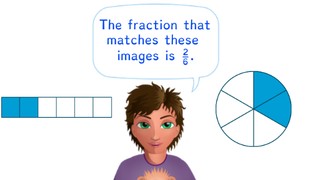



8,000 schools use Gynzy
92,000 teachers use Gynzy
1,600,000 students use Gynzy
General
The students learn how they can read fractions from a fraction bar or a fraction circle.
Standards
CCSS.Math.Content.3.NF.A.1
Learning objective
Students will be able to read fractions from a fraction bar and a fraction circle.
Introduction
Show a number of images. The students must state which fraction matches which image. Draw the written fraction or the speaker to the correct image.
Instruction
Explain that a fraction consists of a numerator and a denominator. After this you explain using a fraction bar how you can read a fraction. First count how many parts the bar is divided up into. Then count the parts that are colored in. If you know these numbers, you can write the fraction. After this, show a few more bars. The students must state which fraction matches each bar. Drag the fraction to the correct bar. Next there are only fraction bars visible, and the students must come up with the fraction that describes each bar on their own. After this you explain through a circle diagram how you can read a fraction. First count how many equal parts the circle is broken up into. Then count the number of colored parts. If you know these numbers, then you can write the fraction. After this, show a few more circle diagrams, each of which is accompanied by a statement. The students must determine whether each statement is true or false. If one of the statements is false, then show an example of what it should be. Next you show the circle diagrams and the students must determine what fraction describes each one.
To check whether the students can read fractions from bars and circles, you can ask the following questions:
- What part of the fraction tells how many parts of the bar/circle are colored in: the numerator or the denominator?
- Which part of the fraction tells how many equal parts the bar/circle is divided up into: the numerator or the denominator?
Quiz
The students test their understanding of reading a fraction from a fraction bar through ten exercises. In some of the exercises they must determine which fraction bar matches the written fraction. In others they must determine what written fraction is shown by the fraction bar.
Closing
You discuss once again with the students how it is useful to be able to read fractions from fraction bars and circles, so that you know what fraction it is. Check if the students know how you read a fraction. Next you play fraction bingo. The students draw fraction bars or circles from 1/2 to 10/10. They determine individually where each of the fractions go on their bingo card. Then you name some fractions. If a student has drawn the fraction you named, then they can cross it off. If someone crosses off all of their fraction bars (or circles), then they have won. There is also a puzzle for the students to solve. Each fraction stands for a letter. On the left side there are fractions written out. The students must find the letter that matches each of the fractions. If they put the correct letters in place of the fractions, then the following message appears: "you can read fractions".
Teaching tips
Students that have difficulty with reading fractions can first practice dividing a fraction bar or circle into equal parts. Next they can color in a number of the parts of the fraction bar or circle. The next step is reading the fraction that they have just drawn. Emphasize that the top number of the fraction tells how many parts are colored in. The bottom number of the fraction tells how many parts the bar or circle is divided up into.
Instruction materials
Paper for bingo.
The online teaching platform for interactive whiteboards and displays in schools
Save time building lessons
Manage the classroom more efficiently
Increase student engagement
Discover more!
About Gynzy
Gynzy is an online teaching platform for interactive whiteboards and displays in schools.
With a focus on elementary education, Gynzy’s Whiteboard, digital tools, and activities make it easy for teachers to save time building lessons, increase student engagement, and make classroom management more efficient.



